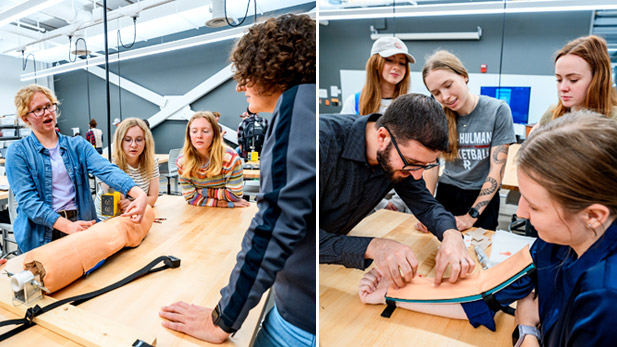Biomedical Engineering Seniors Developing Creative Health Care Training Tools

Senior-year biomedical engineering projects underway for the Rural Health Innovation Collaborative include simulated ligament knee injury and blood vein systems that will help train future local health care professionals.
Senior biomedical engineering students are collaborating to develop new innovative tools that could help train current and future Wabash Valley health care professionals through hands-on approaches to learning. Both also provide interesting under-the-skin perspectives about how the body works.
One device features a series of tension elements that replicate the four knee ligaments to provide a training tool for better assessment of the severity of knee injuries involving these ligaments. Meanwhile, another device simulates the arm’s vein system to help people become familiar with extracting blood samples and donations that are literally the life blood of local hospitals and health care centers.
The devices are part of a five-quarter-long capstone design project that provides real-world experiences by examining problem definition, prototyping, construction, verification, and user validation – replicating industry practices. In this case, the teams’ projects are supporting Terre Haute’s Rural Health Innovation Collaborative in advancing the health and wellness of the public through the interprofessional education and training of health care professionals.
“It’s been interesting to create a device that uncovers how the body works and helps people learn how to best take care of those in need of medical help,” said Elsa King.
She joined classmates Ashley Parker, Karmen Kissell, and Caroline House in creating the Simulated Ligament Injury Knee device that has interchangeable tension elements supporting a knee model, like real ligaments. The device is hidden beneath a silicone skin that looks and feels like human skin. The elasticity of the strips, upon using physical examination techniques, helps medical personnel determine which of the four knee ligaments may be affected and the severity of the injury -- either a partial or a full tear of the ligaments.
The device could be useful for athletic trainers, fitness professionals, and long term care facility personnel who deal with knee injuries and are called upon to make initial assessments about possible care.
“We had to learn a lot about the intricacies of the different types of knee injuries, like an ACL (anterior cruciate ligament) or MCL (medial collateral ligament) tear. Each ligament and associated injury have a different feel and texture,” said Kissell.
Parker added, “The one thing that no device can simulate is the amount of pain associated with a particular knee injury.”
The vein simulator is a wearable device that can be strapped onto a human arm to allow trainees to simulate a blood draw or an IV placement on a “patient”, without harming the wearer. Underneath its silicone skin are two vein-like tubes providing a reservoir of fake blood, like real veins. The system helps train medical professionals to find veins in the forearm and then inject a syringe needle into the vein to extract a blood sample or insert an intravenous catheter.
“There are multiple uses for this training device, and it provides immediate, positive feedback on whether there has been a successful insertion of the needle into the vein,” said project development team member Ashley Black.
There were several design challenges with the project. First, the students needed to find a material that could be punctured easily, like human skin. Then, the tubing for the simulated veins also had to be easily injected and able to release the blood into the syringe or catheter without leaking or bleeding into the supporting materials and would seal to allow for repeated use. Also, a blood-like liquid had to be created to make the system even more realistic.
“We’ve discovered that nothing is as easy as it would seem. Creating synthetic blood became quite a challenge, but lots of fun,” said Jenna Myers. Also contributing valuable ideas to the project were Payton Williams and Maggie Witt.
An extensive design component, starting in a student’s first academic quarter, is a core feature of the biomedical engineering program. Other elements include communication and leadership development, along with background in regulatory affairs and physiology – all led by a skilled and caring faculty and staff.